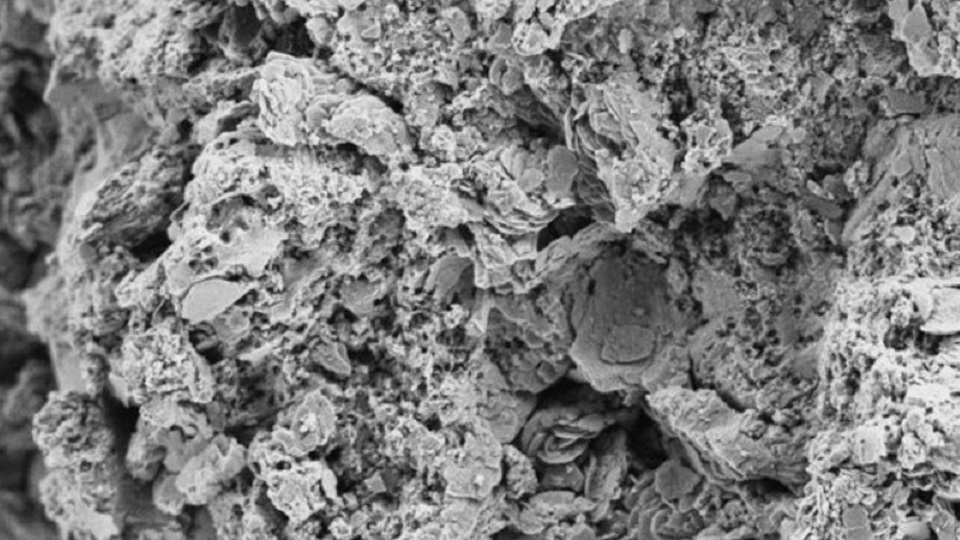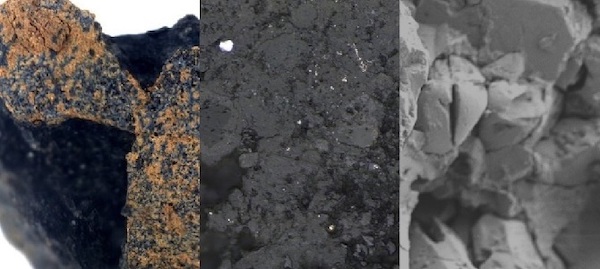A 4.6-billion-year-old meteorite found lying in the imprint of a horseshoe is likely a remnant of cosmic debris left over from the birth of the solar system and could answer questions about how life began on Earth.
It was discovered by Loughborough resident Derek Robson, of the East Anglian Astrophysical Research Organisation(EAARO), in a Gloucestershire field, in March, after travelling from a distance of at least 110 million miles from its primordial home between the orbits of Mars and Jupiter in the asteroid belt.
Scientists at Loughborough University are now analysing the small charcoal-coloured space rock to determine its structure and composition in a bid to answer questions about the early solar system and possibly our own origins.
Along with colleagues from EAARO, researchers are using techniques such as electron microscopy to survey the surface morphology at the micron and nanometre scale; vibrational spectroscopy and X-ray diffraction, which give detailed information about chemical structure, phase and polymorphism, crystallinity and molecular interactions, to determine the structure and composition.
The material, which resembles loosely held-together concreted dust and particles, never underwent the violent cosmic collisions that most ancient space debris experienced as it smashed together to create the planets and moons of our solar system.
“The internal structure is fragile and loosely bound, porous with fissures and cracks,” said Shaun Fowler - a specialist in optical and electron microscopy at the Loughborough Materials Characterisation Centre (LMCC).
“It doesn’t appear to have undergone thermal metamorphism, which means it’s been sitting out there, past Mars, untouched, since before any of the planets were created meaning we have the rare opportunity to examine a piece of our primordial past.
“The bulk of the meteorite is comprised of minerals such as olivine and phyllosilicates, with other mineral inclusions called chondrules.
“But the composition is different to anything you would find here on Earth and potentially unlike any other meteorites we’ve found – possibly containing some previously unknown chemistry or physical structure never before seen in other recorded meteorite samples.”
The ancient rock is a rare example of a carbonaceous chondrite, a type of meteorite which often contains organic material. Fewer than 5% of meteorites which fall to Earth belong to this classification.
Identifying organic compounds would support the idea that early meteorites carried amino acids – the building blocks of life – to supply the Earth’s primordial soup where life first began.
“Carbonaceous chondrites contain organic compounds including amino acids, which are found in all living things,” said Director of Astrochemistry at EAARO Derek Robson who found the meteorite and who will soon join Loughborough University as an academic visitor for collaborative research.
“Being able to identify and confirm the presence of such compounds from a material that existed before the Earth was born would be an important step towards understanding how life began.”
Professor Sandie Dann, of the Chemistry Department in the School of Science, first worked with Derek in 1997 and has kept in touch with him regularly since.
She said: “It’s a scientific fairy-tale. First your friend tracks a meteorite, then finds it and then gifts a bit of this extra-terrestrial material to you to analyse.
“At this stage, we have learned a good deal about it, but we’ve barely scratched the surface.
“There is huge potential to learn about ourselves and our solar system – it’s an amazing project to be part of.”
Jason Williams, Managing Director of EAARO, added: “One of EAARO's primary objectives is to open the doors of science and technology to those who may not get the opportunity.
“Derek and I felt our new find could help us further these objectives by opening up research opportunities in meteoritical science.
“We carefully chose Loughborough, along with University of Sheffield, a number of commercial partners, and a handful of overseas specialists to work with us on this exciting project as we continue to excite and inspire people young and old by promoting and encourage space research and STEM subjects to a wider community.”
The East Anglian Astrophysical Research Organisation (EAARO) was founded in 2011 and has a Space Operations Centre (SOC) near Cambridge, a radio observatory and satellite ground station in Hertfordshire and a meteor radar system project on the Orkney Islands.
Its members include science and engineering specialists, radio astronomers and technical experts who have collaborated with institutions including Arizona State University, the University of Manchester, the Bayfordbury Observatory and the Jodrell Bank Centre for Astrophysics.
The Loughborough Materials Characterisation Centre (LMCC) is a core research facility at Loughborough University that supports researchers who require advanced materials characterisation.
It combines the talents of an experienced team of researchers and technicians together with world-class equipment to offer a unique service to users, both academic and industrial.

